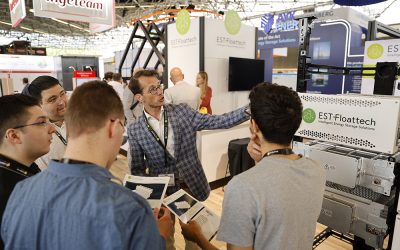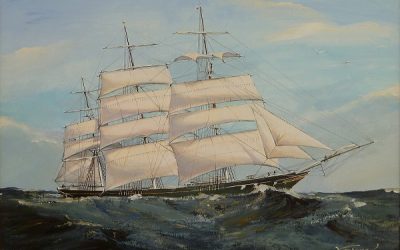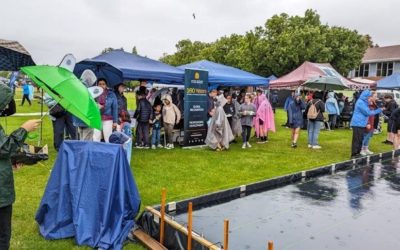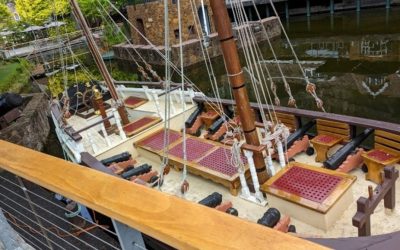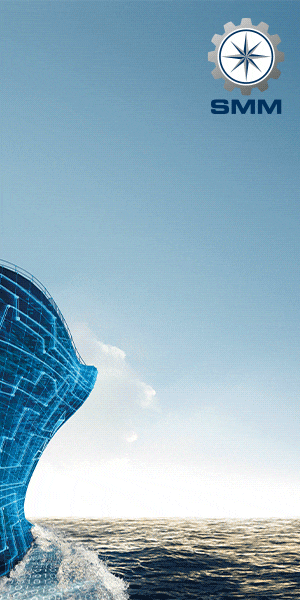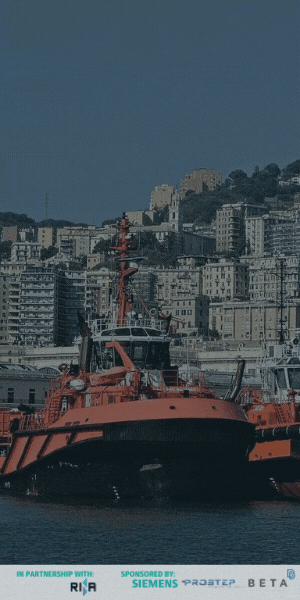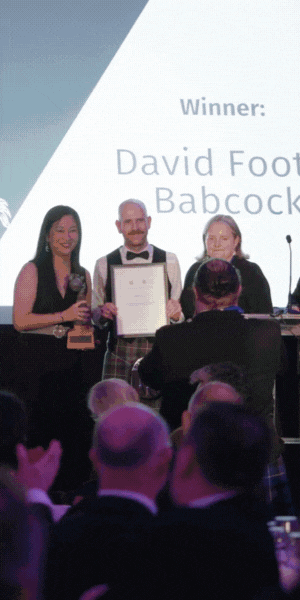Ship & Boat Internatonal: Jan/Feb 2017
Sandia National Laboratories, in collaboration with Washington State-based naval architect Elliott Bay Design Group and the Red and White Fleet, has proven the feasibility of building and operating a high-speed ferry powered entirely by hydrogen fuel cells. The 150-passenger commuter ferry, which would emit zero emissions from operations, is designed for a top speed of 35knots and to service commuters in the San Francisco Bay Area.
The study was funded by the US Department of Transportation’s Maritime Administration and included contributions from class society ABS, the US Coast Guard (USCG), the Port of San Francisco and dozens of other contributors.
The goal was to design a workhorse passenger ferry with sufficient propulsive power to compete with Bay Area commuting options, while simultaneously producing zero greenhouse gas and criteria pollutant emissions on the water.
Named ‘SF-BREEZE’ – an acronym for San Francisco Bay Renewable Energy Electric Vessel with Zero Emissions – the study examined the ship’s feasibility from three perspectives: technical, regulatory and economic. The project team found no major barriers to construction or operation, either for the vessel itself or the associated hydrogen fuelling operations.
“Not long ago, the prospect of pollution-free transportation seemed like science fiction,” commented Maritime Administration administrator Paul ‘Chip’ Jaenichen when the study was made public. “Today, through public-private collaboration on projects like SF-BREEZE, we are making progress to turn it into a reality.”
An SF-BREEZE-style ferry would not be the first hydrogen fuel cell-powered ship in service; low-speed (typically 5-8 knots) touring boats using hydrogen have been used on a few canals and lakes in Europe. But none are designed to have the propulsive power to compete for commuter traffic.
Hull comparisons
The SF-BREEZE is designed to complete four 50-mile round-trips each day, at a top speed of 35knots for about 60% of the transit time. Refuelling could be undertaken around midday, between the morning and afternoon peak commuter periods, and at night.
It is powered by proton exchange membrane (PEM) fuel cells, which were selected from among several options for the power plant due to their low weight and volume, commercial availability, proven track record, zero emission characteristic and power performance.
The study was based on the Hydrogenics HyPM HD30 PEM fuel cell module, while liquid hydrogen (LH₂) was chosen as the fuel in order to minimise the weight and volume of fuel storage.
Selection of the power plant components allowed the Elliot Bay Design Group to undertake a hull comparison study, which ultimately favoured a catamaran-style configuration rather than a monohull or trimaran. This selection was predominantly influenced by speed requirements rather than the power plant, but the catamaran hull’s greater stability also allowed designers to place the LH₂ fuel tank on the top deck of the vessel.
The hull and decks are made of aluminum, which offers weight savings and also is compatible with the use of cryogenic fuel. The study will examine the use of lightweight composite for further weight savings, but that has the potential to increase construction and repair costs.
Design challenges
As with most prototypes, there were design challenges to overcome. For example, hydrogen fuel cells are heavier than diesel engines for a given power output, so achieving the required power-to-weight ratio for the vessel was not straightforward.
Also, the need for speed drove the design to a slightly longer catamaran than comparative vessels deploying more traditional propulsion units. To achieve the necessary safety standoffs from the fuel cells, the designers placed the fuel cells on the main deck of the vessel in a separate compartment, providing the required physical separation between the cells and the passengers.
The USCG and ABS provided input and review verifying that the design was compliant with the applicable rules and regulations, and the identification of any gaps.
LH₂ and LNG are fuels with very similar physical and combustion properties, although there are some differences. For example, at the boiling point of 20K, LH₂ can condense the components of air (N₂ and O₂), whereas LNG cannot condense air at its boiling point of 111K.
Nevertheless, the two fuels have enough in common to use the IGF Code, IMO’s international safety regulations for ships using gases or other low-flashpoint fuels, as the regulatory starting point. That knowledge supported the regulatory review in accordance with the USCG’s 46 CFR Subchapter T – Small Passenger Vessels, which applies to vessels with 150 passengers or less, and less than 100gt.
The IGF Code would form the basis for the hydrogen and fuel cell aspects that are not included in the Subchapter T regulation. ABS Rules for High Speed Craft were also adopted, along with a dozen other regulations, standards and guidance documents to fill in the gaps in the existing marine regulations.
“The SF-BREEZE feasibility study has advanced the available research on the unique challenges of designing a high-speed passenger ferry powered solely by hydrogen fuel cells,” said ABS chief technology officer Howard Fireman. “The collaboration with Sandia and others in the project team has extended our knowledge base and the potential for technology transfers to address the challenge of reducing the industry’s environmental footprint.”
ABS issued a conditional ‘approval in principal’ to verify that the design would be compliant with the intent of the applicable regulations and rules. Combining this assessment from ABS with feedback from the USCG, Sandia, which worked as the project lead and independent technical evaluator, found no regulatory showstoppers and concluded that the vessel would be acceptable from a regulatory perspective once a more detailed ‘ready-to-build’ design was generated in Phase II of the project. Furthermore, the project found no technical or regulatory issues with the hydrogen fuelling operations that would be needed to support its operations.
Build cost
Phases III and IV include plans to build and operate the ferry and station, while Phase V includes extending the hydrogen refuelling operations to fuel cell light duty vehicles which are now commercially available and, eventually, fuel cell buses and trucks.
At today’s economics, the cost of building the first ship from the SF-BREEZE study would be more than double (2 to 3.5 times) that of comparable diesel ferries. The operating and maintenance costs would likely exceed that multiple.
A significant proportion of the build cost is associated with the PEM fuel-cell system, the cost for which is expected to come down as the PEM technology is adopted in other sectors, such as light-duty vehicles. Also, the fuel cell technology itself is expected to advance, potentially reducing unit weights.
Despite the initial premium for the SF-BREEZE, one of its prominent selling points would be its game-changing ability to completely eliminate emissions from the vessel, particularly as IMO recognises that engine efficiency gains and changes in carbon-fuel mixes alone are unlikely to reverse present emissions growth projections.
WTW analysis
As fuel emissions are not solely generated by a ship’s operation, the project team also considered the emissions from the fuel-production pathway and delivery as part of a ‘well-to-waves’ (WTW) analysis.
They investigated the greenhouse gas (GHG) emissions associated with five LH₂ fuel production pathways, including renewable and non-renewable (fossil-fuel based) methods. Estimates were made for the GHG emissions associated with the production, delivery and use of
fossil diesel fuel, as well as for biodiesel, which could be considered a renewable ‘drop-in’ fuel replacement for conventional diesel fuel.
The WTW GHG emissions for the SF-BREEZE using non-renewable (natural-gas derived) LH₂ were found to be significantly higher on a per passenger basis than for the diesel-fuelled ferries currently plying the San Francisco-Vallejo route. However, using renewable LH₂, with the hydrogen derived from biomass or electrolysis of water using renewable electricity, WTW GHG emissions for the SF-BREEZE ferry are reduced 75.8% compared to the comparable diesel-fuelled ferry.
The project team looked at several ways in which the cost premium could be reduced; and those are likely to be revisited in the next phases of the study. But they also examined the assumption of the need for cost parity in the context of the fuel cell electric vehicles currently entering the automotive market.
In that market, despite similar cost premiums between ‘zero emission’ and conventional fuelled versions of the vehicles, not only have vehicle manufacturers determined that they have the commercial viability to launch a product, they have also sold existing vehicle stock and have long waiting lists of customers.“Commercially,” the study’s authors concluded, “the SF-BREEZE has a promising future and may be viable today.”
